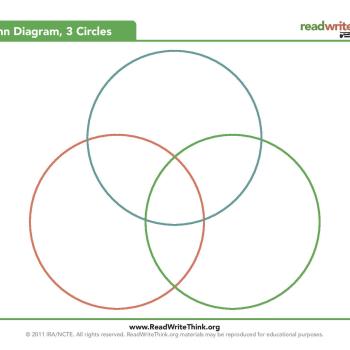Venn Diagram, 3 Circles

About this printout
Students use this graphic organizer to describe similarities and differences between three objects or ideas.
Teaching with this printout
This Venn Diagram with 3 circles helps students identify shared features of three objects or ideas. They can organize similarities and differences before comparing and contrasting:
- three characters.
- three different versions of the same story.
- a literary work and two other pieces of art work (song, painting, dramatic performance, or film).
- any three items that share some characteristics.
Where the circles overlap, students write shared characteristics (things that are the same). In the circles to the left, right, and top, students will list features that are specific to each object (things that are different). Venn Diagrams may be used in any grade level or content area. If this graphic organizer is new to students, practice with topics that have obvious similarities and differences. Before the students use the Venn Diagram, 3 Circles, create an example that compares and contrasts three well-known topics such as famous actors, fruits and vegetables, television shows, or sports.
More ideas to try
- For younger students and kinesthetic learners create large Venn Diagrams on the ground using rope, jump ropes, or hula hoops. Have students compare and contrast topics by moving around from circle to circle explaining why they have chosen each spot. For example, in a social studies classroom the students could use this activity to understand countries during wartime. They could compare their army size, general population, war technology, strategies, leadership, and motivations.
- As an icebreaker or beginning of the year activity, randomly place three students together and have them use the Venn Diagram to organize their similarities and differences. Have the students rotate throughout the class and continue to make different groups of three comparing and contrasting characteristics.
- Use information from completed Venn Diagrams to further practice writing compare and contrast statements with the Compare and Contrast Tool Kit.
- At the end of a unit, chapter, or literature piece, have the students use a Venn Diagram to compare and contrast main characters that they have learned about. Use this activity to re-teach or as a culminating activity.